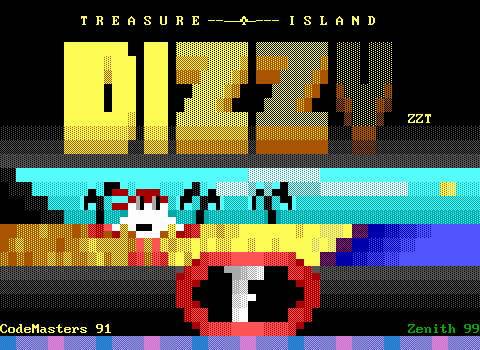The Mountain of Fate and Breath Mints (Gem Searcher)
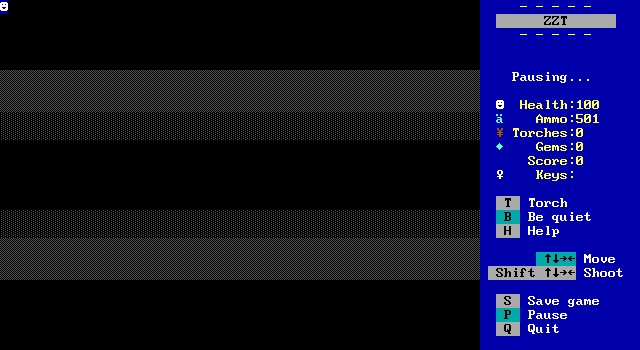
Next up, some frigid mountains and their network of caverns.
This third dimension is one of the more middle of the road ones, something more like Lemmer/Scissorman's stage rather than the incredibly empty Knightt's.
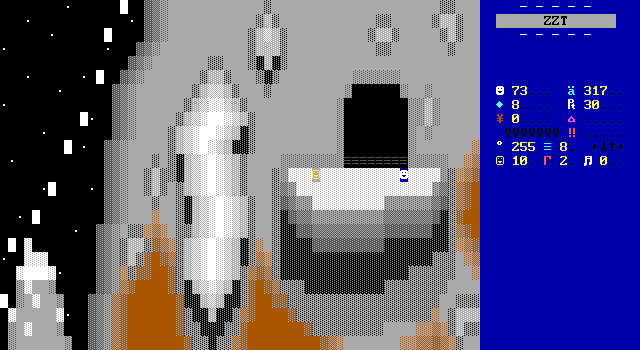
It stands out a little though, thanks to the inclusion of outdoor scenes which give Tseng the chance to flex a little with his visuals. This one is found early on, providing a great first impression to the stage with its starry sky and a simple snow effect using invisibles to animate heavy flakes being blown downward.
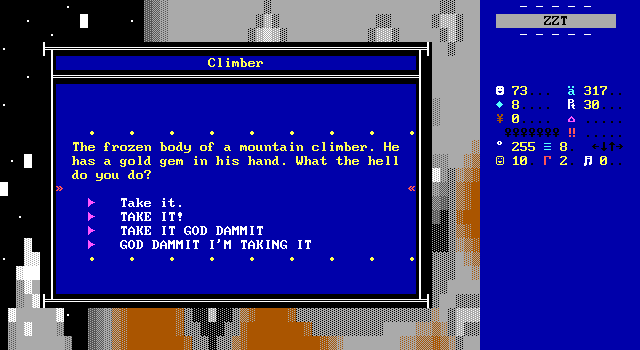
The NPCs are virtual non-existent here. This place is too hostile for random bystanders. The smiley faces here are would-be mountain climbers that didn't make it. This one has died as so many others in the Gem Hunter universe have, with a gem in their hand. Bury me with my precious minerals.
Gem Hunter and crew are built different. The temperature never actually comes into play save for Kim complaining that she really should have brought a coat.
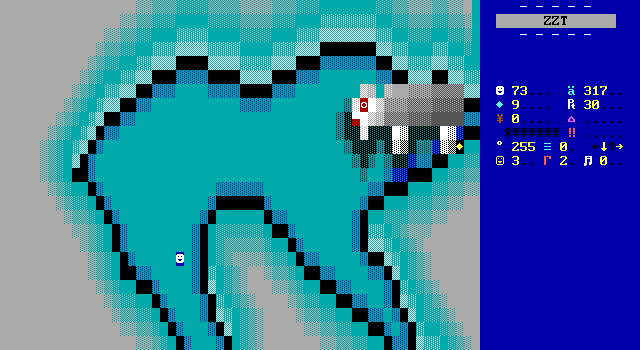
There are some enemies to deal with once again. Including this rather peculiar looking beast that Gem Hunter recognizes as a "Newbie clone". An optional puzzle exists to find a way to take its gem without being noticed.
Though it turns out the puzzle isn't a matter of finding a way to defeat the newbie, just realizing the same board can be reached later on from the other side. Some code exists suggesting this wasn't always the case with a check for an unused flag "newbieaway" leading to an undefined label named "kill".
This beast continues Tseng's longstanding struggles with drawing ASCII art of creatures, including Gem Hunter 2's Espionage and November Eve's hideous Mutant Doberman.
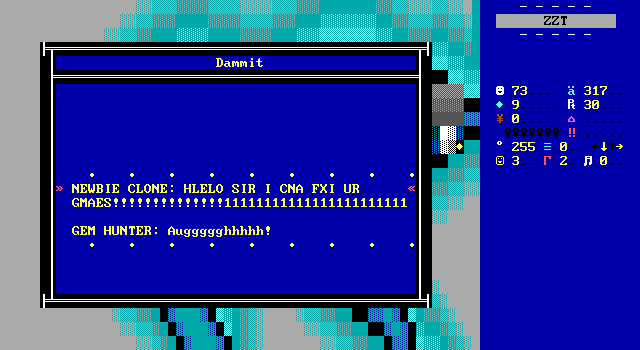
All it takes to be caught is to become aligned with a certain row, meaning players are forced to hug the walls in order to survive. To be seen is to be frozen and killed instantly.
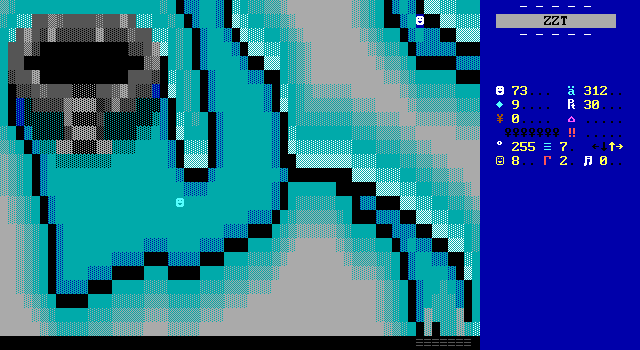
A major factor in my enjoyment of this particular stage comes from Tseng's sudden interest in dividing boards up so that players run through them multiple times in different sections. It's a straightforward way to both make the caverns feel labyrinthine without actually making it difficult to navigate.
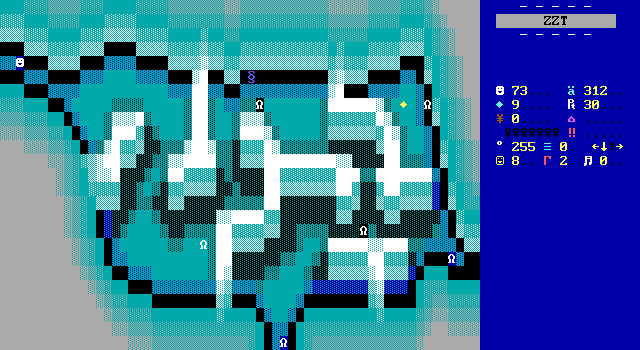
Some action is included as well. This being a game from the year 2000, the ZZT community's rejection of using built-in creatures is in full swing, so while these look like white lions they're objects that constantly try to rush at the player.
The numerous contours of the board keep the enemies from clumping up too badly for most of it. Standing your ground and shooting at anything that rushes you is a guaranteed hit, demonstrating Gem Hunter to be the kind of action hero that can cleanly take down these foes with no fuss.
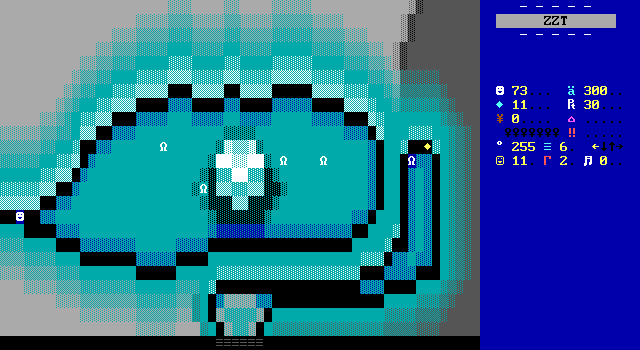
As with the fire world, players do have the opportunity to explore in a few directions in some instances. These paths are just as short as ever, but the presentation works a little better thanks to multiple paths leading to the same board. Here I wandered into a den of ...okay I just looked it up, Tseng names them bears, and gives them the character ZZT uses for lions despite having bears.
Regardless of appearances, these splits can mean finding a gem, or a bunch of hungry bears. Given the game's love of having keys and gems be dropped by certain foes, I took the approach I wouldn't in real life and decided to fight the bears to the death just to be sure. No reward was given, but you know what? That's life baby.
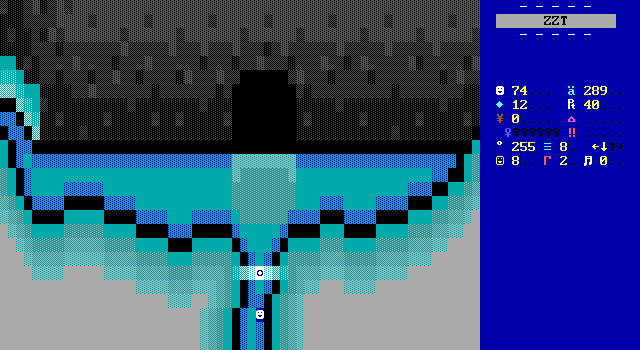
The goal of all this wandering is to find the location of Gem Searcher's lair as well as the blue key necessary to open the gate. This board also connects back to the other side of the Newbie monster, which requires paying close attention to the layout of the board, something players eager to reach the next boss encounter aren't so likely to do. I think this is the perfect choice of boards to link back to the Newbie like this, rewarding those who are patient enough and keep a discerning eye.
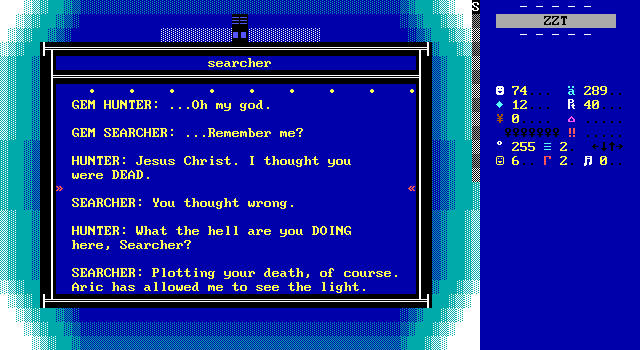
Truthfully, I'm not a fan of Gem Searcher being a boss. Half the plots in these games amounts to "You know that guy who died? Well, he got better. Also he's going to kill you now." This is all well and good when we're dealing with the big name villains who need to return to reset the status quo for the start of the next game, but Gem Searcher isn't that. Gem Searcher is the guy who died before the first Gem Hunter, with Gem Hunter taking over his mission. He's a complete non-character once again in a game full of ZZTer cameo bosses.
You know who was in the ZZT community in the year 2000 with a name appropriate for the boss of an ice world? coolzx.
Okay, it doesn't have to be coolzx, but it doesn't have to be Gem Searcher either. This guy has been alive the entire duration of this series and that will not be explored in any way. He's as important of a character to this series as the cameos are, just a little blip to be killed off and then never mentioned again. Why does he even want to kill Gem Hunter? They were co-workers! (Okay, there is an explanation for this in a later stage.)
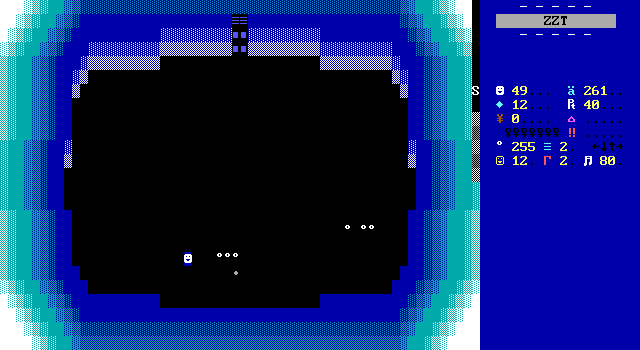
The fight itself isn't that exciting. Searcher spends most of his time being invisible. (I guess that's how nobody noticed he was still alive before.) He then backs off and begins shooting. Lure him towards a corner to limit his escape path and it's not too hard to land some shots on him.
In addition, he has a slashing attack to match his sword animation from the stage opening. This hurts pretty badly, doing twenty-five damage. Luckily it's only active at certain points in his combat loop, and he'll always be visible during such times so it's easy to dodge.
Something about this fight and the assumed-dead character being alive made me wonder how much of an influence Metal Gear Solid's Cyborg Ninja was here as well. This is compounded by the Newbie's code from earlier where if your stealth approach fails, the label jumped to in order to kill the player is named "snake".
The Alternate #DarkDigital (ChanOP)
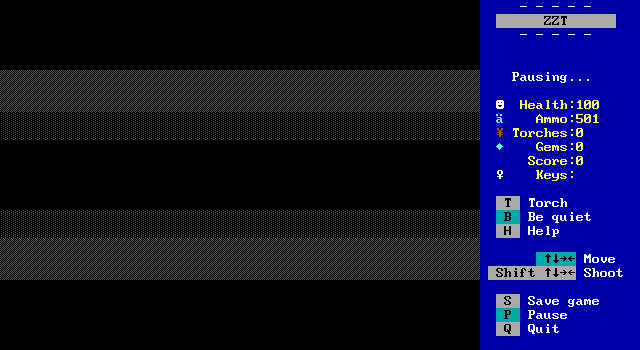
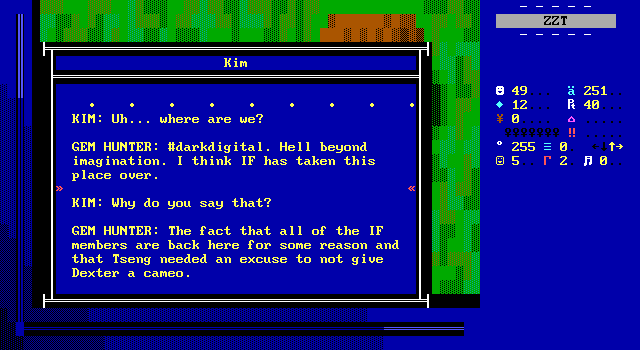
The world of #darkdigital is another dimension that's extremely light on things to do. As if Tseng hadn't loaded the game up with cameos enough, this one is an interpretation of the popular late 90-s ZZTer IRC chatroom ran by GChucky whose cameos have deliberately not been featured yet.
While the original channel was more of a general purpose ZZT community hangout, Tseng opts to load the place up with Interactive Fantasies members, which makes for a very rehashed environment as November Eve went out of its way to both cameo and kill every member of IF. So these aren't just familiar faces for those in the community at the time, but also for anybody that's played Tseng's previous releases.
Those deaths, were of course cartoony rather than malicious, with Tseng himself being a member of IF for Gem Hunter 3's release. I could have sworn November Eve also was published under the label, but now I'm not actually finding anything to support that. Still, if they let him in afterwards, it's clear there were no feelings of ill-intent towards anyone.
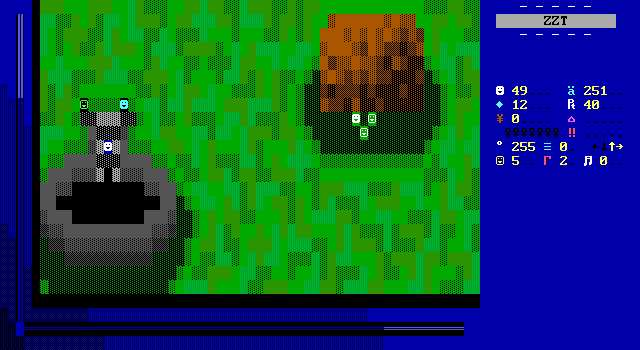
The world itself is one of the more lacking stages. It's very much like Knightt's, with IF members instead of pirates. The cameos are a bit rougher as well, with the very first person players run into being the Agonizer, who is hanging out with some drug-addicted sex workers described with far less flattering terms.
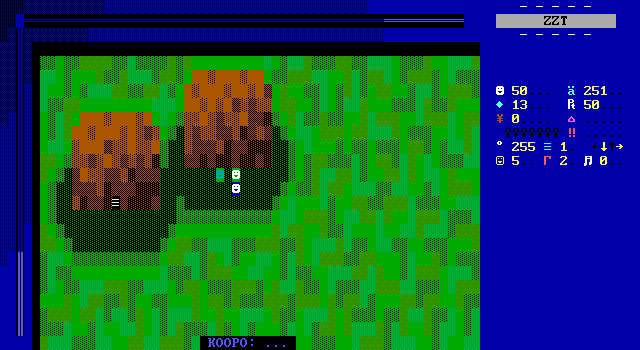
It's by far the shortest dimension to explore. Four exterior boards, one tiny building that can be entered, and a short castle sequence that's over almost as soon as it begins. This one lives and dies on its cameos, and it doesn't do much living.
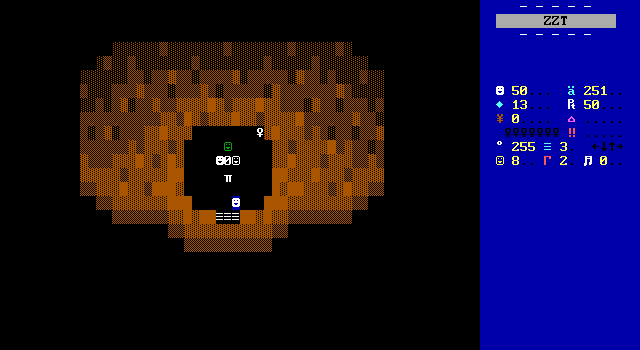
Said tiny building consists of Zenith Nadir, the Almighty Cow, Hercules, and HM playing a very illegitimate game of poker where HM cleans house thanks to his five aces. HM Five Aces, that's what they should call him.
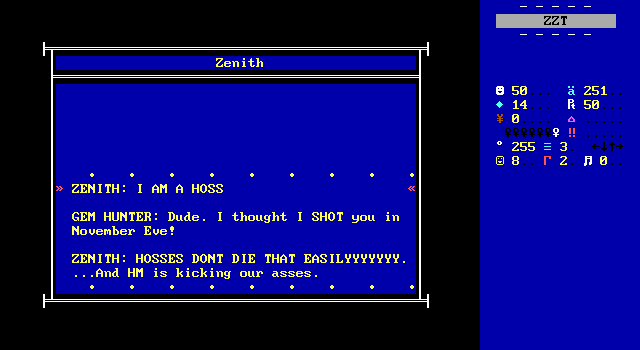
The text is pretty bland. Hercules makes a ^_^ face, Cow complains he looks like a tiger, and HM gives you a gem to not expose his cheating. Nadir's lucked out into catching my attention thanks to all the "HOSS" speak, something that was equally confusing in Fantasy World Dizzy. I guess some folks just go through a hoss-era.
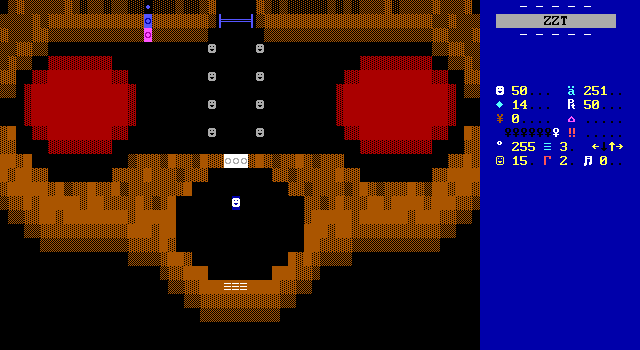
Unlike Knightt's realm, the castle here isn't just the boss fight, and thank goodness. Instead players get a small amount of action to tide them over from all the text they just glazed over. There are two keys to find within the castle, and then a button to lower the barrier. The action doesn't actually start until the button is pressed which of course also causes the statues to begin to attack.
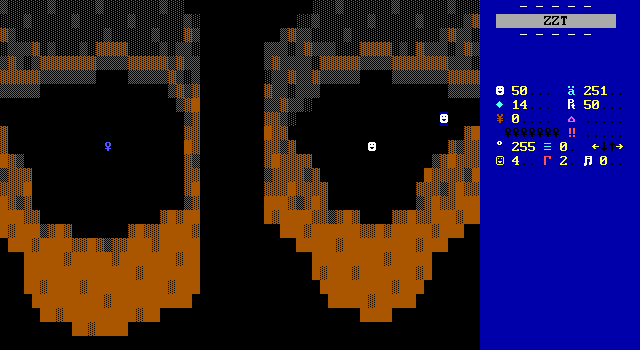
While the rest of the world is hardly anything noteworthy, one aspect of the design that I did quite like was the unusual method of board connections to the entrance. Each exit leads to this board, putting the player on either side. It's quite unusual to see the connections wrap around with one another like this.
Of course, that means that the quest for the two keys takes place across two screens.

On this side, Voidght makes his cameo, quoting what I believe was the description of an item in an early Interactive Fantasies game by Hercules or Hydra, which in turn is a not-quite quote from Raiders of the Lost Ark.
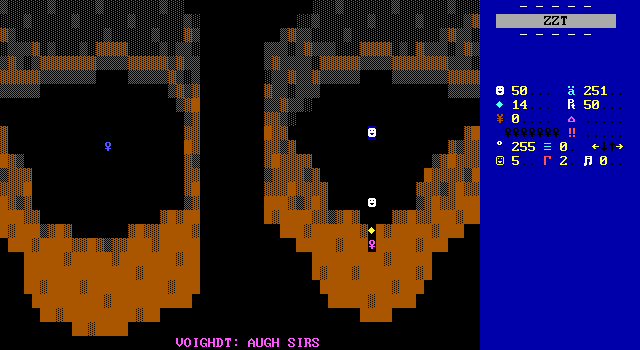
But enough about popular 80s films. Voidght decides to smash his head repeatedly into the wall, eventually breaking it open to reveal a gem and one of the keys Gem Hunter needs. It's his lucky day. Voidght then explodes into a pool of blood as one does.

The other side just has a "Tseng is lazy" joke, a form of self-criticism that I can't recall anybody other than Tseng making. Both of these keys are just handed to the player without any obstruction at all, cementing #darkdigital's legacy as an incredibly boring place, hardly the "Hell beyond imagination" Gem Hunter described it as when he the group first arrived.
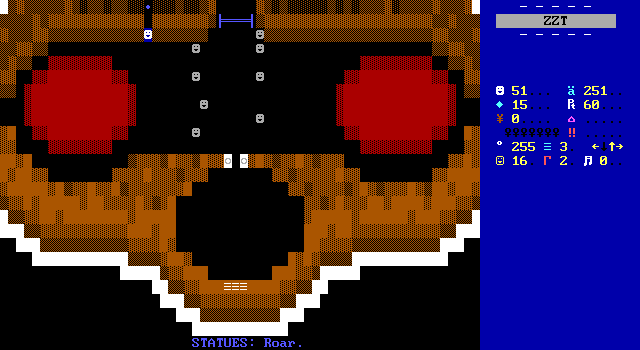
Pressing the button is the only real action to be had prior to the boss battle. The statues move slowly as statues often do making them hardly a threat. With Knightt's world I was at least willing to give it some leniency as the "first" stage being a gentle introduction. This world just sucks to play.
About the only other interesting thing the world does is this graphical effect for its interiors, where a white border radiates outward across the background every so often. It looks neat and all, but I have no idea what it's meant to represent. Is it supposed come off as high-tech since this is an electronic space? Nothing else here feels that way at least.
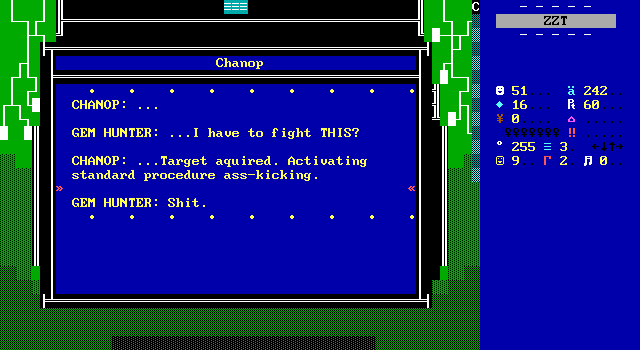
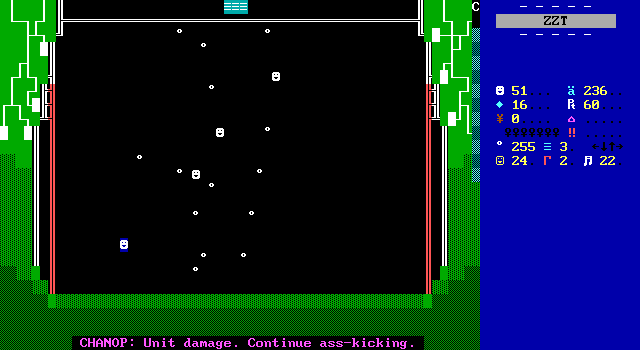
The boss is also a let down, even among the otherwise reasonable bosses seen so far. ChanOP was a bot in every IRC channel on AustNet (and other) IRC servers whose purpose was to let channel operators quickly perform certain actions without having to use dedicated IRC commands. A simple "`kick Tseng" would be all you'd need to remove him from the channel temporarily.
Since a good number of ZZTer IRC channels lived on AustNet to make it easy for those already in #darkdigital to go elsewhere, it's not uncommon to see ChanOp as a robot in a ZZT world. This is probably the first time I've ever fought them though.
ChanOp at least does shake things up somewhat, creating several clones of themselves at the start of the fight which make this fight a bit more frantic. The clones are immune to damage, so players need to track the real target. This isn't all that difficult as the clones are invisible at the start of the fight to surprise players when they show up. Meanwhile the real ChanOp is always visible, and thus easy to pick out right from the start.
The real ChanOp also actually moves towards the player constantly, pulling themselves away from the clones as the player tries to distance themselves from their bullets. This is a blessing for the gameplay since invulnerable clones kept near the real deal would result in ChanOp being blown to pieces with minimal player involvement. Now as you try to dodge their bullets, so does ChanOp by virtue of them trying to be wherever you are.
It almost works out, but Tseng made one critical mistake. ChanOp idles after their line about continuing the ass-kicking in order to prevent the one-line message from being handled by ZZT's parser as a two-liner, with a second blank line where the label jump occurs. This has the side effect that you can very trivially stun-lock them by just shooting with no breaks. The screenshot shows ChanOp already one hit away from death, with five more points of damage already locked-in.
Had this issue not been present, either by just shutting ChanOp up or making another object handle the text display, I think this would have been a step in the right direction for the game. Instead, the dullest dimension is also stuck with the most trivial boss fight.
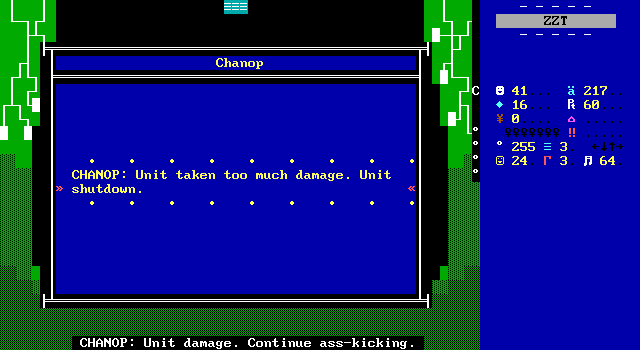
After being defeated, ChanOp shuts down and players can return to the stage select.
The Evil Mansion (BlueMagus)
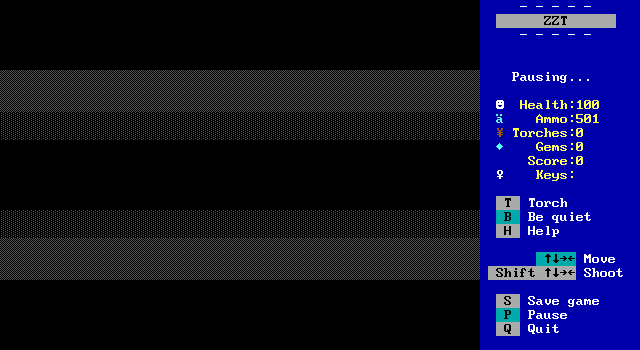
But then, after four stages that have been unable to offer much more than so-so action at best, BlueMagus's dimension is a desperately needed glimmer of hope for players. Gem Hunter 3 is more than just a cash-in on cameos and easily recognizable Da Hoodians for Tseng to use to coast his way to success. This is the world that saves the game from total mediocrity.
Finally, Tseng delivers a dimension that really feels like work was put into its creation. Visuals that are more than basic fades with paths carved into them. Objects to interact with that are more than cameo dolls with a string to pull to make them say a catchphrase. There's just a little bit more here, and it's enough to give Gem Hunter 3 something to offer that you can't find just as easily in dozens of other worlds.
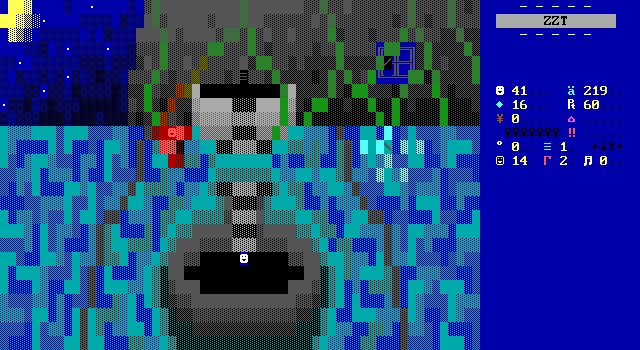
This is the first landing screen since the beginning that had me excited. BlueMagus a.k.a. Anthony Testa, was the ZZT community's little horror/dungeon-crawler prodigy of the era, and unlike all the other ZZTer realms seen previously, Tseng tries to build something that fits the character rather than dropping Lemmer and Skullie into a volcano world.
Arriving outside a spooky mansion on a moon-lit night, the scene is immediately set on this lovely scene hinting at the horror to come. In as much as "there's a dead body outside" is a hint, but hey, there's also glass from a broken window.
The weird cyan ground is likely a compromise for a lit night-scene, still the same old grass found elsewhere, but it makes this world actually stand out from Knightt's and ChanOp's.
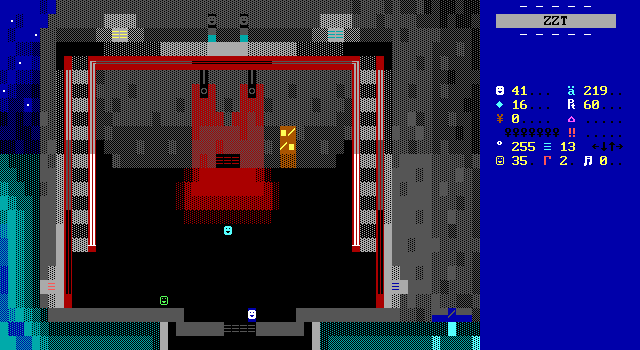
But this isn't really an outdoor environment. The mansion is the real setting here, which again is a nice departure from the previous worlds' habit of sending Gem Hunter to roam the front lawn until he finds the item or key that lets him into a castle of sorts.
Instead, it's very original Resident Evil, with Tseng openly admitting as such at one point with one of the "puzzles". I know that I had to put it in quotes, but _puzzles_. This dimension has _puzzles_.
And it provides the player with options for how to tackle the mansion! This foyer instantly provides access to much of the interior, with five different paths available, split across two floors, with Tseng doing a nice job of delineating the upper and lower levels, managing to spread things out while still keeping them at arm's reach.
There's this nice colored lighting effect on the one door of the lower level which is bathed in blood-red spotlights. Can't say you see mixed colors of lighting very often in ZZT. It's hard to resist the call to check it out first, though being the closest entrance as well, the odds are I would have started there regardless.
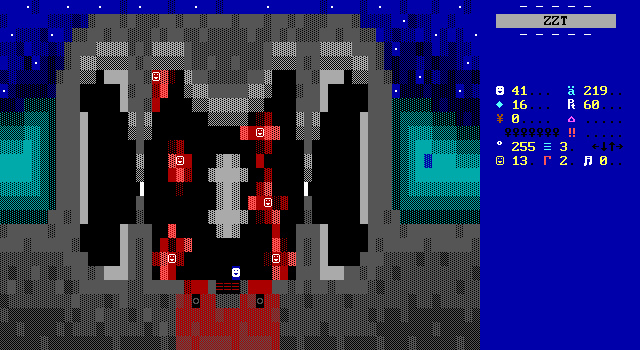
As important as it looks on the outside, the interior is pretty barren. The room is filled with so many mutilated bodies that even Gem Hunter is uncomfortable with the carnage. It's unclear who or what killed them all, but surely it's still lurking somewhere in the mansion.
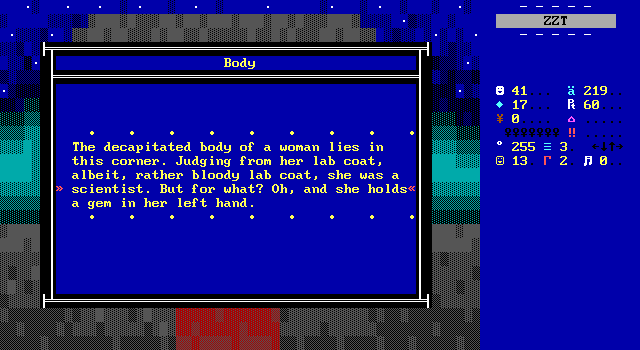
Exploration is rewarded of course with the expected gem from one of the bodies. I hope if I am ever killed in mysterious circumstances that I can at least have comfort in my final moments by caressing a gem.
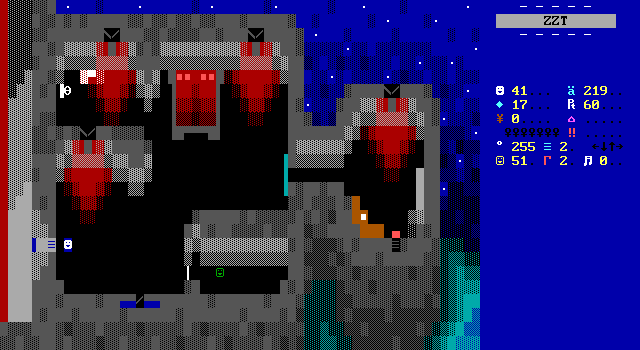
The rooms upstairs have much more to them. Players get a fun moment upon entering this bedroom of watching as a zombie makes it way towards a door, while Gem Hunter himself remains blissfully unaware that he's in danger. Similarly, a painting on the wall has a secret passage that players can see while Gem Hunter cannot.
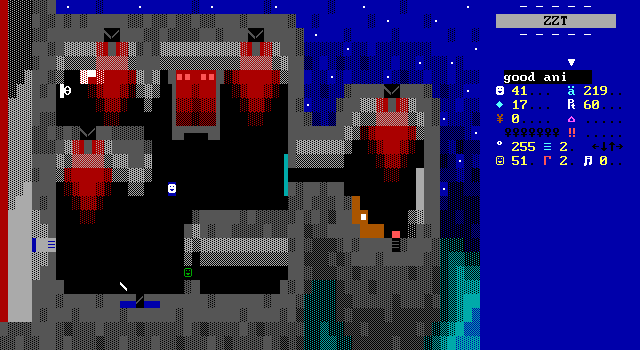
A rare ZZT jumpscare occurs soon after. The zombie's initial movement is entirely scripted, appearing to be a zombie that just moves towards the player at all times and gets stuck on the door. Cheekily, I opted to ignore the creature until I had explored everything else, confident that I was safe.
But no! After a set amount of time the door goes flying, crashing into the wall as part of a nice looking animation. Credit to Tseng for genuinely surprising me like this.
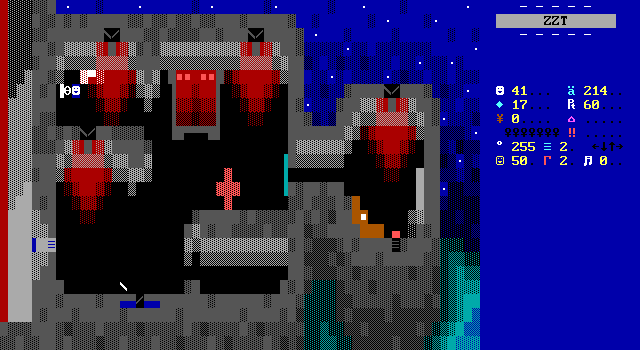
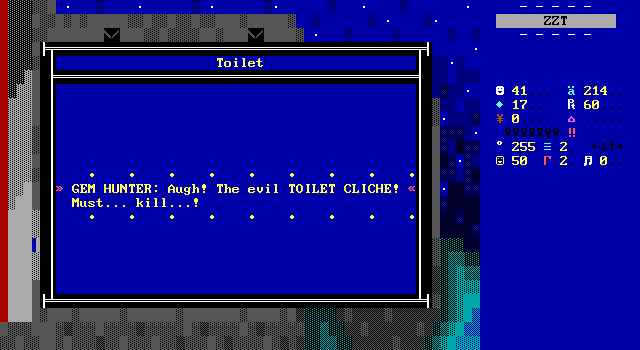
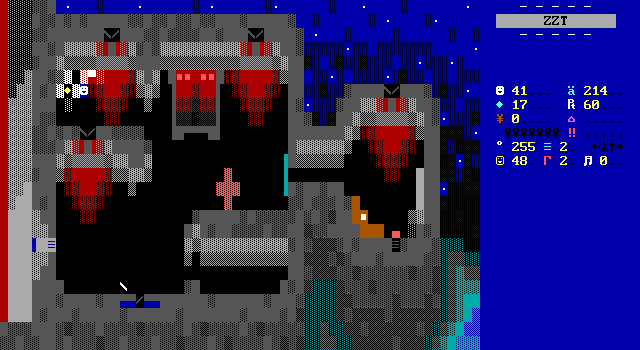
The obligatory ZZT toilet appears as well, which Gem Hunter can't help but destroy, almost as if he knew there was a gem in there.
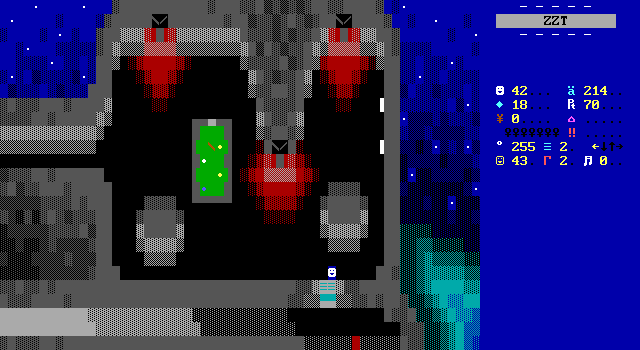
Over in the game room, players are treated to one of the most impressive gags I've seen. The eastern wall has two slot machines which can be played freely. Slots in ZZT are nothing new, though these ones aren't a randomized mini-game, but rather hard-coded to deliver the same results every time.
The lower one always matches three "æ" characters, perhaps a nod to the Goobers of Ned the Knight, though the other symbols used are also very non-traditional slot machine icons, even by ZZT standards.
For winning, players receive five shots to the face, which again surprised me so much that I died. To a slot machine. This is undoubtedly the most I have ever been owned by a ZZT game.
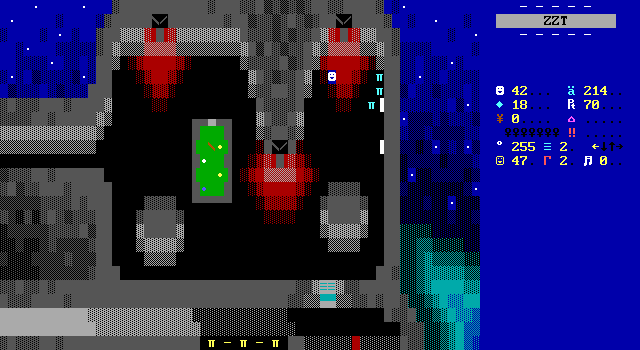
The upper one is even better. You match on three tigers, and a bunch of tigers get spit out. For as reluctant as ZZTers were to use built-ins, nobody could resist this gag. I'm just a little disappointed that it generates more than three of them.
The only other item of interest here is the pool table, which replicates a puzzle from Resident Evil by having the cue sticks and balls arranged to form a clock face. Tseng isn't subtle about this, making Gem Hunter outright recognize the puzzle and credit its origin in-universe.
If PlayStation games exist in the Gem Hunter universe, does this include Parasite Eve?
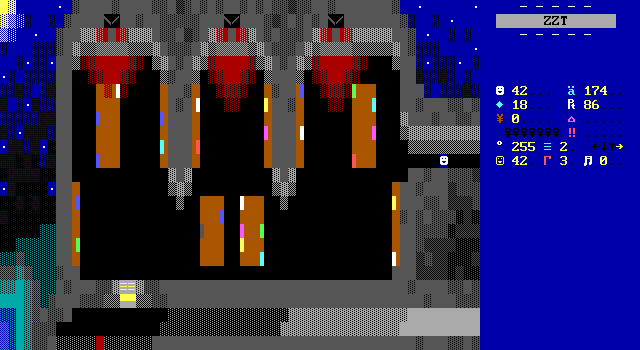
The game room connects directly to the library which can also be reached from a passage in the lobby. It's nice to not have to finish exploring some of these rooms and just turn around, though it must be infuriating to try and read something while the sounds of billiard balls being smacked around is happening in such close proximity.
A library means Tseng gets the opportunity to amuse the player with a whole lot of book titles. Alternatively, this is also a great soapbox for Tseng to stand on, making it easy to posit that his hot takes could fill entire books.
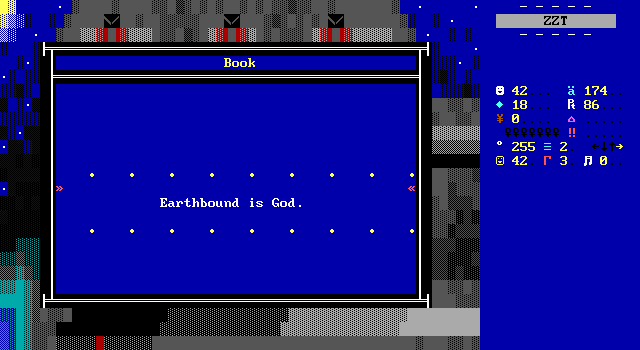
Like, almost immediately we get RPG takes!
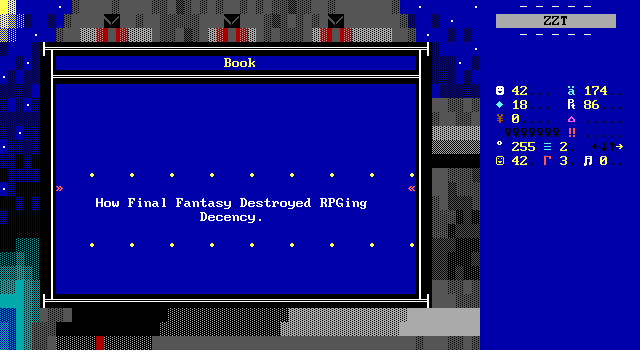
Several actually! It's certainly not all this. There are a good number that try to be funny as well, they just aren't all that amusing today.
What Tseng means by "RPGing Decency", I haven't the slightest idea. This man literally named himself after a character from Final Fantasy VII
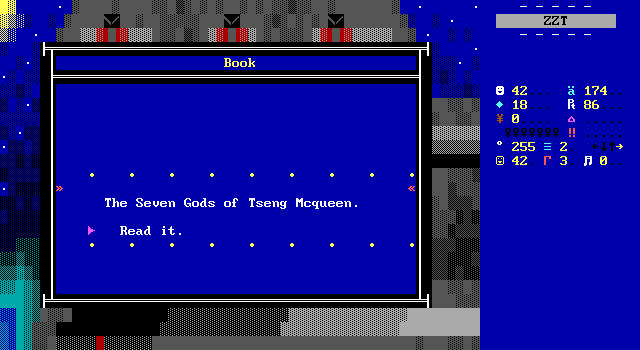
A rare few books can actually be read. If you want to know about the kinds of creatives Tseng considers to be gods and why, then this book is for you. Peter Gabriel, Wyclef Jean, and George Carlin appear on this list among others.
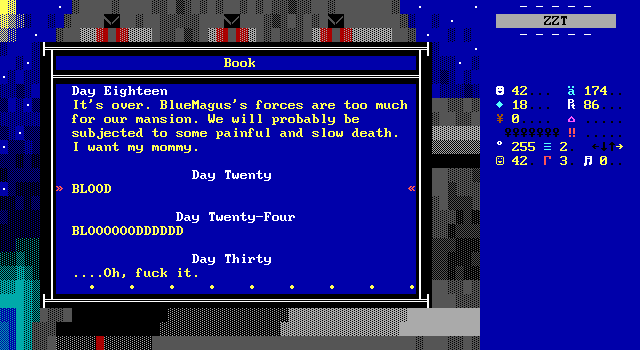
The library isn't just for the sort of humor and rants expected of a GeoCities website, it's got a single book that actually provides some vague information about what's been going on in the mansion. It's all the usual stuff. Experiments gone wrong, and now an unstoppable killing machine with an army of zombies is picking off the team that created them.
The book provides a gem to players that read it, though this goes unmentioned compared to the rest in the mansion. Nothing in here actually needs to be interacted with, which is the case for the majority of the mansion really. You need to look at the pool table to learn what to do with the grandfather clock in the lobby, and that's it. Still, even while this book is optional, Tseng does expedite things for players who don't want to spend ten minutes reading everything in sight by hinting at this book's importance by making it dark gray when everything else in the library uses bright colors instead.
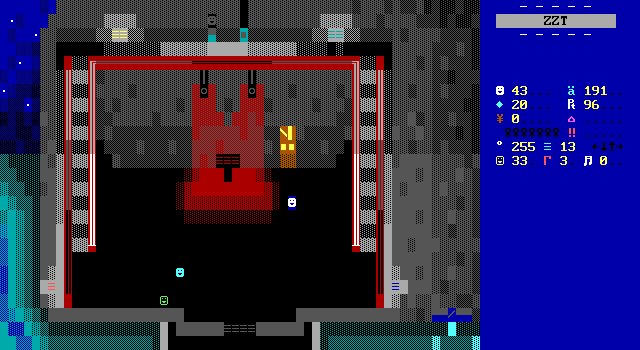
The only thing players need to do to get through this stage is check the pool table, grab a key lying on the ground in the guest bedroom, adjust the clock to move one of the gargoyles upstairs, and then use the password to enter the mansion's underground laboratory from behind the painting in the master bedroom.
Though the critical path is short, Tseng included so many extra items to interact with here compared to the previous worlds that it will take players much longer to get through if they're having fun engaging with the content provided. Reading opinions about how Pokémon is evil may be a bit of a snooze-fest, but it's hard to resist exploring when you're finally permitted to.
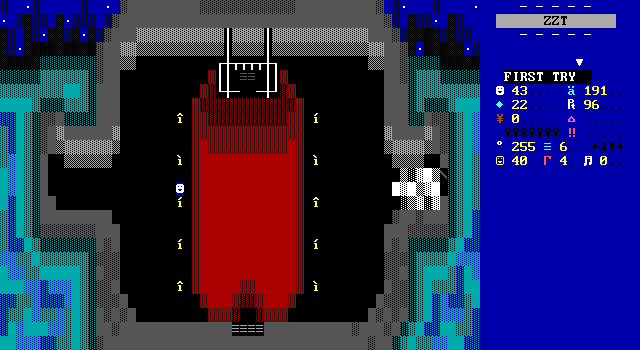
The split between the lab and the mansion parallels the castles and surroundings seen previously. The elevator leads players down to this spooky candle-lined hallway, the last safe board before dealing with the monster of the mansion that isn't the dimension's boss.
Any seasoned adventurer should immediately have the urge to check every candle for a hidden gem. That repetition means something has to be different about one of these. Miraculously, I just ran to one on the side here and immediately found the lone gem. I was very proud of myself.
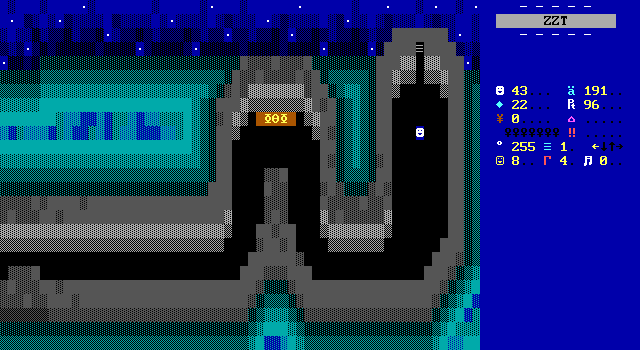
Deeper below, Gem Hunter has his encounter with the "Iron Bastard", a nigh un-killable creature that bursts out of the wall and gives chase across this board. They may just be a smiley face, but if they catch you, Gem Hunter is killed instantly. The trinkets visible along the northern wall are just tricks to make the player waste their time. None of them can even be interacted with.
The bastard does have one unique trick up his sleeve that like the slot machines before, really took me by surprise. Upon bursting from the wall debris scatters on the ground, matching the quality of animation seen elsewhere in the game. I had hoped I could snag the creature on the debris only to learn that the monster wasn't slowed in the least, simply destroying the debris in its path rather than take the extra cycles to navigate around it! Impressive stuff.
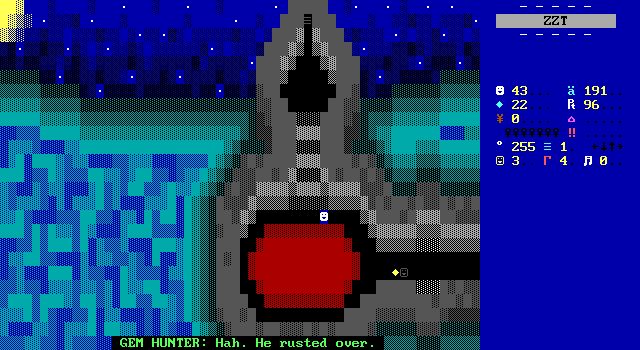
Less impressive is how the encounter ends. Reach the next board and the monster stops chasing, appearing after a moment before turning to rust and becoming immobile, dropping a gem first of course.
Gem Hunter usually isn't the kind of guy to run away, so this doesn't feel particularly satisfying. Given the tight timing and multiple attempts needed to get through the first board though, I can't deny feeling relief at the chase coming to a halt.

For the finale, BlueMagus makes his appearance, and given the deliberately cramped space used for the fight he's unable to do any fancy animations with his weaponry the way other bosses have.
This fight has some similarities to another November Eve boss with Dexter where both himself and Kim were on the outside of a rectangle with ricochets to bounce bullets around and only a few small alcoves in the middle to duck into. This boss was noted as the game's most difficult by a significant margin given how binary the dodging was, with players frequently being shot many times in a row.
This time things are toned down a little with BlueMagus on the outside circling the perimeter and shooting constantly inward. It's still a pain to dodge everything given how little room there is, but now players can at least park themselves and try to time a few shots of their own to counteract BlueMagus's, something far easier than Kim who had to wait for an attack meter to fill before being able to inflict any damage.
BlueMagus isn't the actual target either. For no stated reason, a panel on the wall sometimes opens up which needs to be shot to deal damage to BlueMagus. It might not make much sense, but it's the only boss since Lemmer and Scissorman that felt unique in any way. Figuring out how to hurt the bosses was a big part of Gem Hunter 2, though that game played around with coming up with creative methods of attack a lot more than just a panel being exposed.
Defeat BlueMagus and the barrier disappears allowing players to return to the stage select screen.
The mansion is by far the most interesting stage. I don't know why this one seems to have gotten all the attention focused on it. I'm just glad Gem Hunter 3 finally delivered. The only real flaw with this one is that in the event the player returns to the stage to look for any gems they may have missed, the iron bastard will still be active on the first board, and on the opposite side from where the player enters which would turn the chase into more of an incredibly high-stakes football game where you really do not want to be tackled.

